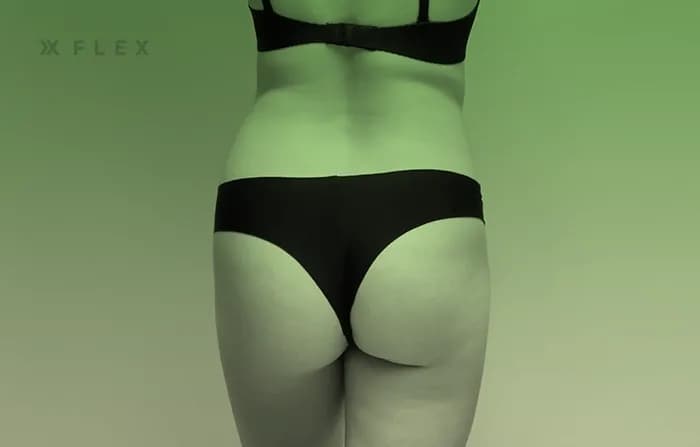Inverted Butt: How to Turn Your V-Shaped Glutes Round
These tips will help you make your inverted butt round. Get targeted butt-building exercises and learn about the gluteus muscles' anatomy.
Although we think all butts are great, there’s always room for improvement when it comes to your glute fitness regimen.
Get to know the inverted V butt type. Find out what factors may contribute to an inverted butt shape.
Plus, if you’re not happy with your inverted butt, learn the best glute workouts to round out your booty for a more balanced butt shape.
What is an Inverted V-Butt?
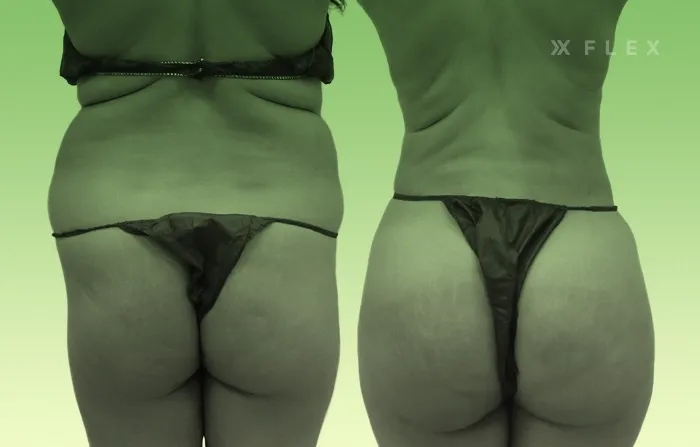
To begin, an inverted butt or V-shaped butt is a butt that holds more volume at the top and less volume at the bottom.
This gives it an upside-down triangle or V-shape.
Although much of the way your butt looks is simply determined by glute genetics, several lifestyle factors go into giving you an inverted butt as well.
Being sedentary or overweight can contribute to more weight around the top of your butt near your abdomen. It can factor into why you’re not seeing the perky round butt that you’d like to in the mirror.
Shape-wise an inverted butt suffers from too little muscle development throughout the lower and mid-glutes, with more weight held on top near your abdominal area.
This mainly has to do with the gluteus maximus muscles.
Danielle Picard breaks down the V glute shape and highlights some tips and tricks to improve
Next, let’s get a little rundown on the butt muscles and what factors may be at play if your butt looks inverted.
Gluteus Maximus
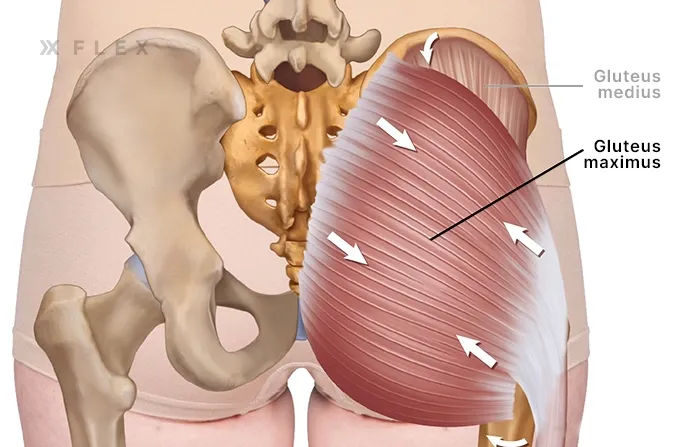
First off, the gluteus maximus is your body’s biggest muscle. This muscle is located at the back and center of your seat. Fortunately, because it’s so big, it can be easier to strengthen.
Located at the middle-back part of your glute muscle group, the gluteus maximus helps straighten your leg at the hip joint and brings the leg into full extension when you lift it.
The gluteus maximus also helps you externally rotate your thighs to turn your legs out.
For a balanced booty that loses the inverted shape and looks more round, you’ll need to create more volume at the base of the glutes.
Working your gluteus maximus muscles can help the appearance of your glutes here.
Gluteus Medius

Secondly, the gluteus medius sits between the gluteus maximus and gluteus minimus muscles.
You work this muscle mostly during side-glute exercises.
Moves like a single-leg press or banded hip abduction warm-up can help you build up your gluteus medius.
If your butt is inverted, you may have a strong gluteus medius, since part of this muscle connects to the upper glute area, where inverted butts tend to store more volume.
Regardless, if you want an all-over balanced booty, continuing to work your medius muscles along with the other muscles, where you may have an imbalance can help you with a more even-looking derriere overall.
Gluteus Minimus
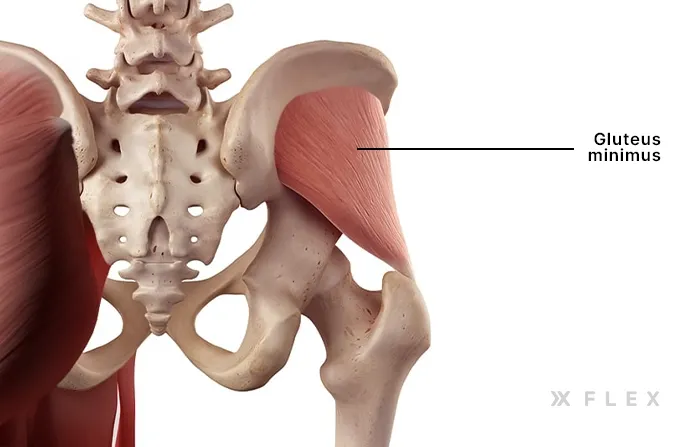
Finally, the gluteus minimus is your smallest gluteal muscle, sitting under the gluteus medius.
It mostly works to abduct your hip (move your leg away from your body) and help with hip rotation.
All three gluteal muscles work in tandem to create a powerful glute area and help the posterior chain muscles along the back of your body. Building a strong posterior chain helps you run, jump, sit, get up, and perform any movement you’ll need in your everyday life.
A strong posterior chain can also help alleviate lower back pain. Not only are glute workouts great for helping this chain to strengthen, but working the “pull muscles” of your back is also linked to reducing low back pain.
How to Turn an Inverted Butt into a Round Butt
If you’ve determined that your booty is indeed looking like an upside-down triangle, you’re probably wondering how to turn your V-shaped butt into a round one.
To make your inverted butt look more round, there are two factors you’ll have to consider:
- Reducing fat around the waist and abdominal area and
- Building up the lower glutes.
Let’s look at a few solutions to build up your muscles to get a more shapely physique if you have an inverted butt.
Inverted Butt Workout
What exercises target an inverted butt shape?
Here are a couple of moves you can add to your arsenal to round out your booty.
Hip Thrust
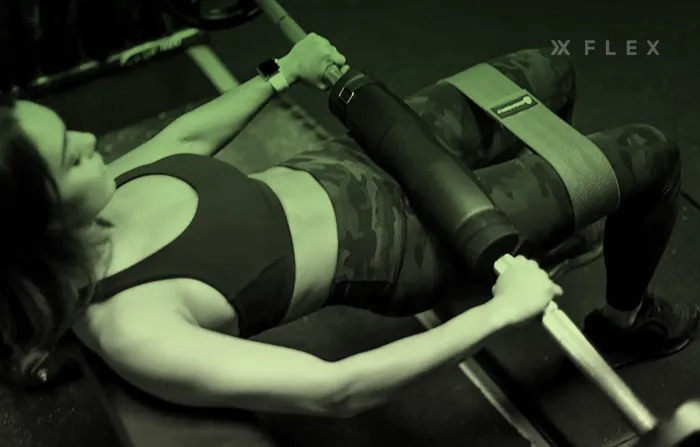
The hip thrust is one of the best booty-building moves you can do for developed glutes. Hip thrusts are more of a glute isolation move than either squats or deadlifts.
This exercise is similar to a glute bridge, only you perform it on a weight bench to elevate your back and increase your range of motion.
- Using a weight bench, sit on the floor and place the upper part of your back against the bench.
- Roll a barbell over the top of your legs, bringing it to rest at your hip crease, right against the tops of your thighs. You can use a pad or folded yoga mat to protect your pelvis if you find using a weight hurts your hip bones.
- Push through the feet, squeeze your glutes, and drive your hips upwards.
- Think about sending your hips towards the sky.
- Bring your body up until the front body comes to a straight position and your knees are bent at 90 degrees.
- Hold this move for a moment, then slowly come down with control.
- Repeat as needed.
- For beginners, aim to do 3 sets of 10-12 reps. More experienced lifters can try 3-4 sets of 6 heavy reps to target the glutes.
- Hold or pulse at the top to increase the burn. You can also perform a hip thrust hold by holding your hips up to feel a burn.
Romanian Deadlifts
Romanian Deadlifts (RDLs) are some of the best moves for developing your lower glutes.
Although both RDLs and conventional deadlifts can target the glutes, some evidence shows that an RDL variation works less of your erector spinae (spinal flexors).
This may allow you to keep more of the work in your low glutes, not your back.
RDLs use an even bigger range of motion than something like a hip thrust. Because of this, your muscles get a good amount of time in both the concentric (the “up” movement of a lift) and eccentric (the “down” stage) parts of this move.
How To Do Romanian Deadlifts (RDLs)
To perform proper RDLs for glutes:
- Load a heavy weight onto your barbell.
- Grip the barbell and stand with your feet hip-width apart. Your shins should be almost touching your barbell.
- Pick up your weight, keeping your core engaged and back straight. Make sure your shoulders are strong and not hunching over.
- Drive through your feet, pushing your butt backward to lift your weight off the ground. Keeping your arms and legs straight, use the legs to pull your weight up.
- When your barbell passes your knees, squeeze the buttocks at the top of your movement.
- Hold for a pause, then slowly hinge at your hips to push your butt behind you, bringing your weight back down.
- At the bottom of the movement, do not put your barbell back on the floor (unless you’re training a one-rep max), but continue for reps.
- If you are new, try 3-4 sets of 10 reps with light weight. Aim for heavier weight at 4 sets of 6 weights if you have more experience.
Pro tip: Hinge from the hips, NOT the back. This deadlift variation is more leg-dominant than a traditional deadlift, which does work more of your lower back muscles.
Although the RDL does incorporate your erector spinae (the muscles that flex your spine), keeping the move concentrated on your legs will give you more glute activation.
Bending your spine can also be dangerous and lead to injuries, so keeping proper spinal alignment is paramount here. If you can’t tell what your back is doing in this movement, turn sideways so your sides are facing a mirror.
You’ll be able to check your form and make sure the hinge is coming from your hips.
Training Tip
Use hand straps in your Romanian Deadlifts if you find grip strength is causing you trouble. Although it’s important to train your hand grip, the deadlift should be about hitting your glutes and hamstrings.
If you find grip is preventing you from lifting heavy weights with your legs, use a strap to keep your barbell anchored to your wrists.
Stepmill
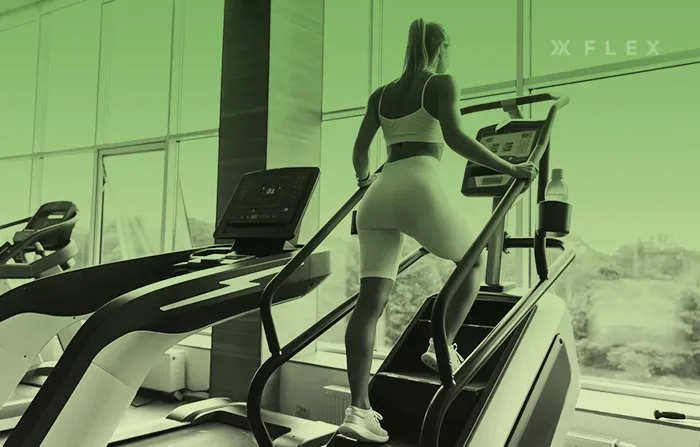
Stairmasters and other types of stepmills require you to perform a climbing movement to target the glutes.
As we mentioned earlier, folks with inverted butts may hold more fat near the abdominals and less in the hips and thighs.
This machine helps work your cardio and lung capacity while also hitting the glutes.
To use the stepmill:
- Choose a comfortable time and resistance setting. For fitness newbies, aiming for a 30-minute step session at a moderate pace is a good goal to work towards.
- If you are more experienced and looking to use the stepmill only as a warm-up or to train at intervals, start with 10-15 minutes, then change your resistance or proceed with the rest of your workout.
Most commercial gyms have stepmill machines. By combining your cardio with a glute builder workout, you’re able to target both factors that could contribute to your inverted butt.
No stepmill? No problem. Take it outside and try a workout on a real set of stairs! It’s free and you’ll get some fresh air.
You can try running up and down the stairs with fast feet multiple times for an intense cardio burn, or simply taking a route with stairs on an outdoor walk.
Other Butt Exercises
These are just a few moves you can use to target an inverted butt. Comprehensive moves that target all parts of the butt are great to continue to build all-over glute strength. Try to incorporate glute moves like:
- Squats
- Lunges
- Traditional deadlifts
- Glute bridges
- Box jumps
And other leg exercises into your routine to continue your glute growth and strength development.
Invert your bad workouts and make them awesome. Flex offers an all-in-one workout platform to help you learn new exercises, visualize your fitness journey, and keep all your PRs in one place.
We’ve made it simple to work on customized fitness plans or to introduce a little friendly competition to your fitness community by sharing exercises with your friends. Try it for free through the Flex fitness app.
References:
Del Zotto, M., Framorando, D., & Pegna, A. J. (2020). Waist-to-hip ratio affects female body attractiveness and modulates early brain responses. The European journal of neuroscience, 52(11), 4490–4498. https://doi.org/10.1111/ejn.14209
Elzanie A, Borger J. Anatomy, Bony Pelvis and Lower Limb, Gluteus Maximus Muscle. [Updated 2023 Apr 1]. In: StatPearls [Internet]. Treasure Island (FL): StatPearls Publishing; 2023 Jan-. Available from: https://www.ncbi.nlm.nih.gov/books/NBK538193/
Greco AJ, Vilella RC. Anatomy, Bony Pelvis and Lower Limb, Gluteus Minimus Muscle. [Updated 2023 May 22]. In: StatPearls [Internet]. Treasure Island (FL): StatPearls Publishing; 2023 Jan-. Available from: https://www.ncbi.nlm.nih.gov/books/NBK556144/
Kościński K. (2014). Assessment of waist-to-hip ratio attractiveness in women: an anthropometric analysis of digital silhouettes. Archives of sexual behavior, 43(5), 989–997. https://doi.org/10.1007/s10508-013-0166-1
Manolopoulos, K., Karpe, F. & Frayn, K. Gluteofemoral body fat as a determinant of metabolic health. Int J Obes 34, 949–959 (2010). https://doi.org/10.1038/ijo.2009.286
Nauli, A. M., & Matin, S. (2019). Why Do Men Accumulate Abdominal Visceral Fat??Frontiers in physiology, 10, 1486. https://doi.org/10.3389/fphys.2019.01486
Shah A, Bordoni B. Anatomy, Bony Pelvis and Lower Limb, Gluteus Medius Muscle. [Updated 2023 Feb 17]. In: StatPearls [Internet]. Treasure Island (FL): StatPearls Publishing; 2023 Jan-. Available from: https://www.ncbi.nlm.nih.gov/books/NBK557509/
Tataryn, N., Simas, V., Catterall, T., Furness, J., & Keogh, J. W. L. (2021). Posterior-Chain Resistance Training Compared to General Exercise and Walking Programmes for the Treatment of Chronic Low Back Pain in the General Population: A Systematic Review and Meta-Analysis. Sports medicine - open, 7(1), 17. https://doi.org/10.1186/s40798-021-00306-w
Related articles


Get fit with Flex
Build muscle & lose weight fast for free.
Available on iPhone + Apple Watch
